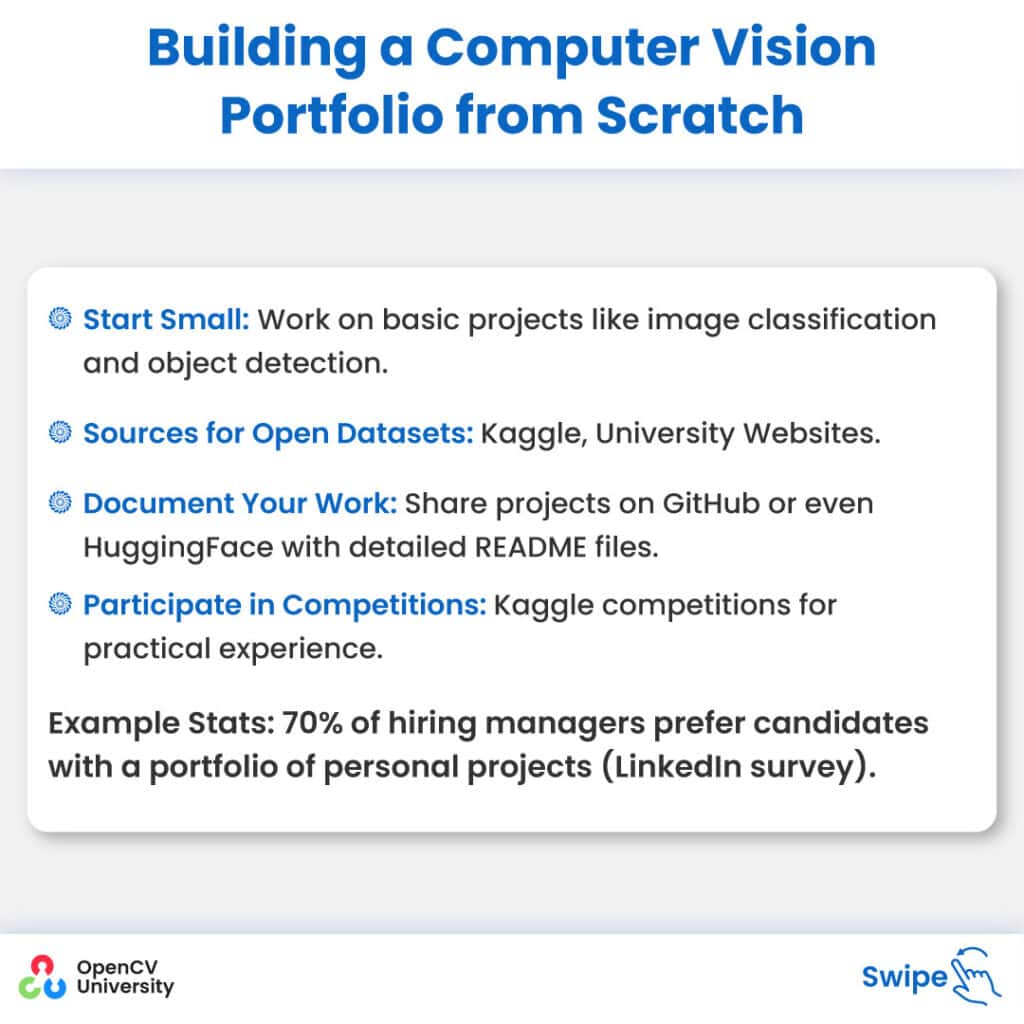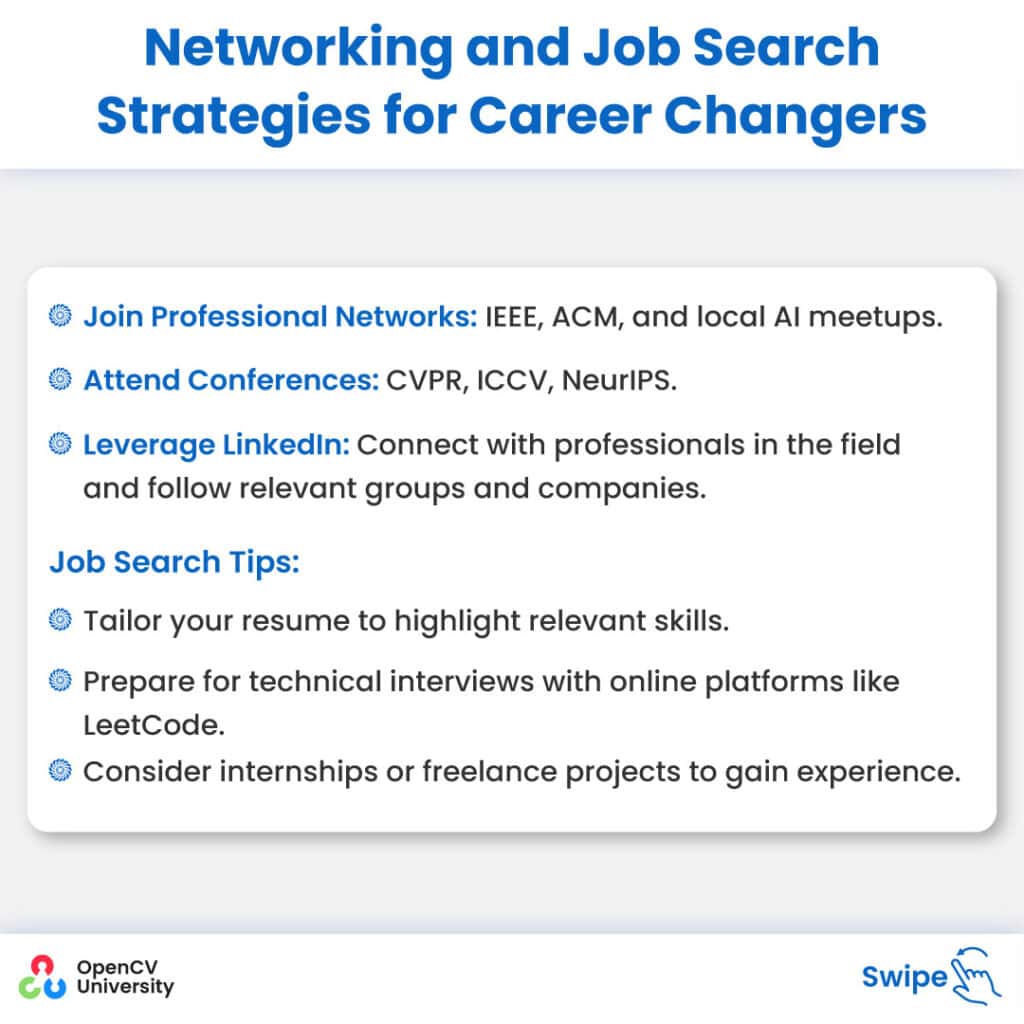Building a Winning Resume: Essential Tips for Emerging Computer Vision Engineers
Creating a strong resume is key for making a great first impression. For computer vision engineers, it’s not just about listing qualifications—it’s about showcasing your unique skills and practical experience in a way that grabs attention. Here, we’ll explore practical tips to craft a resume that highlights your technical expertise and real-world achievements.
Quantify Achievements
Numbers tell a story better than words alone. Highlight your accomplishments with clear metrics that showcase your impact. For instance, instead of writing, “Worked on an image segmentation project,” you could say, “Developed a custom image segmentation algorithm that improved diagnostic accuracy by 8%.”
This approach demonstrates your ability to solve problems and deliver measurable results, making your profile stand out to potential employers. Always aim to show the value you added through your work, whether it’s through improved efficiency, accuracy, or other tangible outcomes.

Emphasize Technical Skills
Your technical skills form the backbone of your resume. Highlight the tools, programming languages, and frameworks that demonstrate your expertise in computer vision and deep learning. Use structured sections to ensure clarity and make it easy for recruiters to spot key competencies.
SAMPLE:
Technical Skills
Programming Languages:
- Proficient in Python , (C++ as an add-on)
- Developed several projects using Python for image processing and machine learning tasks.
Computer Vision Tools and Libraries:
- Skilled in using OpenCV for image processing, feature extraction, and real-time video processing.
- Experienced in applying TensorFlow or PyTorch for building and training deep learning models.
Machine Learning and Deep Learning:
- Foundation in machine learning algorithms, including supervised and unsupervised learning.
- Hands-on experience with deep learning techniques such as CNNs, Transformers, and GANs for computer vision tasks.
Data Handling and Analysis:
- Competent in using NumPy and pandas for data manipulation and analysis.
- Experienced in data visualization using Matplotlib and Seaborn to interpret data trends and model performance.
Development Environments and Tools:
- Familiar with Git for version control.
- Used Jupyter Notebooks extensively for prototyping and testing machine learning models.

Tailor Your Resume
A generic resume doesn’t stand out. Tailoring your resume to match the job description shows that you’ve taken the time to align your skills and experiences with the employer’s needs.
For example, if a job posting emphasizes deep learning experience, highlight relevant projects and tools like TensorFlow or PyTorch prominently. Similarly, if a role focuses on real-time systems, mention your expertise in optimizing image processing workflows or working with libraries like OpenCV.
Customizing your resume also helps it pass Applicant Tracking Systems (ATS), which screen for specific keywords. By mirroring the language in the job description, you increase your chances of catching a recruiter’s eye.

When tailoring your resume, be honest about your skills and experience. Exaggerations may pass initial screening but can fail during interviews, damaging trust and credibility.
Taking this extra step ensures your resume feels relevant and purposeful, making it more likely to move forward in the hiring process.
Detail Oriented Bullet Points
Strong bullet points bring your experience to life. Use action verbs and include specifics to show your role and impact on projects. Avoid vague descriptions—be precise about what you did and the results you achieved.
For example:
- Enhanced object detection algorithms by implementing model quantization and optimizing inference pipelines, achieving a 30% boost in processing speed with minimal impact on accuracy (mAP).
- Optimized image segmentation pipelines by leveraging parallel processing, batch normalization, and code refactoring, reducing execution time by 20% and enhancing model scalability.
- Designed an anomaly detection system using Python and TensorFlow, implementing feature extraction, dimensionality reduction, and threshold optimization to achieve 95% precision in detecting rare events.
Each point should clearly convey the skills you applied, the actions you took, and the results you delivered. This approach highlights your contributions and gives employers a clear idea of how you can add value to their team.
Include Practical Experience
Employers value hands-on experience, even if it’s gained through internships, academic projects, or personal work. Highlight relevant experiences that showcase your ability to apply computer vision and machine learning in practical scenarios.
SAMPLE:
Computer Vision Intern
XYZ Tech Inc., January 202x – June 202x
- Developed Real-Time Object Detection System: Designed and implemented a real-time object detection system using Python and OpenCV, achieving a 15% improvement in detection speed and accuracy.
- Collaborated on 3D Reconstruction Project: Assisted in developing a 3D reconstruction algorithm from stereo images, enhancing model precision by 20%.
- Optimized Image Processing Workflows: Reduced image processing time by 30% by optimizing existing algorithms and implementing parallel processing techniques with CUDA.
Academic Project: Autonomous Navigation System
University of Tech, September 202x – December 202x
- Designed Pathfinding Algorithms: Developed and tested pathfinding algorithms for an autonomous robot, resulting in a 25% increase in navigation efficiency in unknown environments.
- Implemented Computer Vision Techniques: Utilized machine learning models for terrain recognition and obstacle avoidance, increasing the system’s overall reliability and performance in real-world tests.
Personal Project: Facial Recognition System
January 202x – Present
- Built a hybrid facial recognition and verification system using Python and TensorFlow. Leveraged ArcFace for extracting discriminative facial embeddings for recognition and a Siamese network optimized with triplet loss for robust face verification.
- Implemented MTCNN for accurate face detection and alignment, ensuring consistent preprocessing for downstream tasks.
- Enhanced performance by integrating model quantization for faster inference and applying data augmentation techniques to improve generalization, achieving 90% accuracy on a dataset of 1,000 faces.

Even limited work experience can be impactful if presented effectively. Focus on the skills you applied, the technologies you used, and the outcomes you achieved. This shows your potential and readiness to tackle real-world challenges.
Education and Certifications
Clearly list your educational qualifications and certifications to highlight your academic foundation and specialized training. Including relevant coursework and certifications adds credibility and showcases your commitment to professional growth.

SAMPLE:
Bachelor of Science in Computer Science
University of Tech, Graduated May 202x
- Specialization: Computer Vision and Machine Learning
- Senior Project: Developed a machine learning model for automated image classification, increasing accuracy by 10% over existing models.
Relevant Coursework:
- Advanced Machine Learning
- Computer Vision Systems
- Neural Networks and Deep Learning
- Data Structures and Algorithms
- Robotics and Automation
Certifications:
- CVDL Master Program: OpenCV University, Completed December 202x
- Covered advanced topics in computer vision, including image analysis, object detection, and neural network implementation.
Master Program Included:
- Mastering OpenCV with Python
- Fundamentals of Computer Vision & Image Processing
- Deep Learning with TensorFlow & Keras
- Deep Learning with PyTorch
- Computer Vision & Deep Learning Applications
Listing your education and certifications in a structured manner makes it easy for employers to identify your academic strengths and professional expertise. Ensure that any certifications are directly relevant to the role you’re applying for.
Also Read: 10 Interview Questions for Senior Computer Vision Engineers
Soft Skills and Collaboration
While technical expertise is critical, soft skills and the ability to work well with team are equally important in tech roles. Highlight your interpersonal abilities to show you can collaborate effectively in team environments and contribute to project success.

SAMPLE:
Communication & Teamwork
- Presented technical findings to diverse audiences, ensuring clarity and gaining support for project objectives.
- Collaborated with multidisciplinary teams to successfully integrate computer vision technologies in production.
Analytical & Problem-Solving Abilities
- Devised solutions for complex technical challenges, resulting in significant improvements in project outcomes.
- Analyzed data trends to refine algorithm performance, boosting efficiency and accuracy.
Soft skills demonstrate your readiness to work in dynamic environments where teamwork and adaptability are essential. Be specific about how these skills have contributed to the success of past projects, reinforcing your ability to thrive in professional settings.
Must Read: Enhance Your Resume with These Essential Computer Vision Projects
Moving Ahead
Crafting a standout resume as a computer vision engineer is about more than just listing skills—it’s about presenting your expertise and achievements in a way that resonates with potential employers.
Take the time to refine your resume, and let it tell the story of your journey and potential—because a well-prepared resume isn’t just a document; it’s your first step toward building the career you’ve envisioned.
Following up on your application is important by mailing the recruiter or sending a direct message to them in Linkedin. Read more about such tips in our article ‘Networking and Skill Enhancement for Computer Vision Professionals‘
Ready to elevate your career in computer vision? Check out CareerX, our specialized AI Career Program designed to help you stand out. With expert mentorship, tailored guidance, and comprehensive support, you’ll build a competitive profile and unlock new opportunities in AI.
Learn more about CareerX and see the roadmap of all its features: CareerX Program.
Ready to take the first step in your AI journey? Enroll in one of our FREE bootcamps or courses and start building your expertise today!
Free OpenCV Bootcamp:
Master image processing and computer vision basics for free. Start here: Free OpenCV Bootcamp
Free TensorFlow Bootcamp:
Learn the foundations of deep learning with TensorFlow. Start here: Free TensorFlow Bootcamp
Free Python Course:
Beginner-friendly Python course to build your programming foundation. Start here: Free Python Course
For a comprehensive learning experience, explore the Computer Vision Master Bundle—the world’s most in-depth collection of courses on AI, Computer Vision, and Deep Learning: Computer Vision Master Bundle
Take the next step toward mastering AI and transforming your career today!
The post Building a Winning Resume: Essential Tips for Emerging Computer Vision Engineers appeared first on OpenCV.












































 Programming Skills: If you’re already familiar with languages like Python or C++, you’re on the right track. These languages are widely used in computer vision, particularly Python, due to libraries like OpenCV and TensorFlow. Even a basic understanding of coding can be a great starting point since many tutorials and projects will build on what you already know.
Programming Skills: If you’re already familiar with languages like Python or C++, you’re on the right track. These languages are widely used in computer vision, particularly Python, due to libraries like OpenCV and TensorFlow. Even a basic understanding of coding can be a great starting point since many tutorials and projects will build on what you already know.
 Online Courses:
Online Courses:
 Start Small: Begin with basic projects, such as image classification or object detection. These foundational tasks are relatively simple but show your ability to work with computer vision tools and datasets. You can find plenty of tutorials and datasets online to guide you through your first projects.
Start Small: Begin with basic projects, such as image classification or object detection. These foundational tasks are relatively simple but show your ability to work with computer vision tools and datasets. You can find plenty of tutorials and datasets online to guide you through your first projects.
 Join Professional Networks: IEEE, ACM, and local AI meetups.
Join Professional Networks: IEEE, ACM, and local AI meetups.
 Review Your Transferable Skills: Reflect on the programming, analytical, mathematical, and domain-specific knowledge you already possess. These can form a solid foundation as you move into computer vision.
Review Your Transferable Skills: Reflect on the programming, analytical, mathematical, and domain-specific knowledge you already possess. These can form a solid foundation as you move into computer vision.